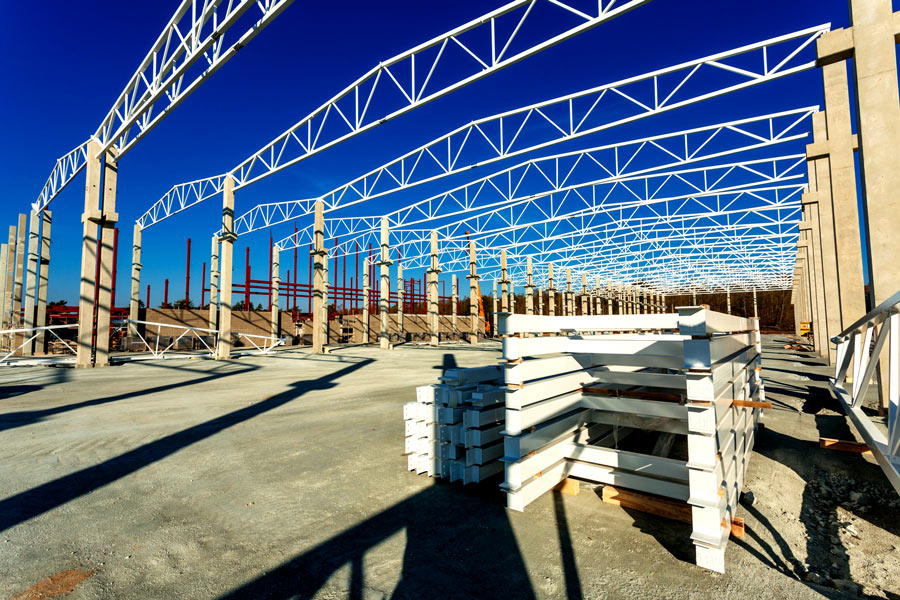The Art of Designing and Building Steel Frame Agricultural Buildings: A Comprehensive Guide

Welcome to the ultimate guide on designing and building steel frame agricultural buildings! If you’re looking to create a durable, versatile, and cost-effective structure for your farm or ranch, then you’ve come to the right place. In this comprehensive blog post, we’ll walk you through everything you need to know about the art of designing and constructing steel frame agricultural buildings. From selecting the right materials to maximising space efficiency, we’ve got you covered. So grab your hard hat and let’s get started on turning your agricultural dreams into reality!
Introduction: The importance of efficient and durable agricultural buildings
Agriculture is the backbone of our society, providing us with essential food, fuel, and fibre. As the demand for agricultural products continues to increase with the growing population, farmers are faced with the challenge of maximising their efficiency and productivity while also minimising costs. One crucial aspect that can greatly impact agricultural operations is the design and construction of buildings on a farm.
Efficient and durable agricultural buildings are essential for any farming operation. They not only provide shelter for equipment, livestock, and crops but also serve as storage facilities for valuable items such as feed, fertiliser, and machinery. These structures need to be designed in a way that meets the specific needs of the farm while also being able to withstand harsh weather conditions.
One material that has gained popularity in recent years for its strength, durability, and cost-effectiveness is steel. Steel frame agricultural buildings offer several advantages over traditional building materials like wood or brick. Not only are they more resistant to fire and pests, but they also require less maintenance and have a longer lifespan.
Efficiency is key when it comes to agriculture; therefore, every element on a farm must be designed with functionality in mind. Agricultural buildings should be strategically placed on site to optimise workflow and minimise time spent transporting materials from one location to another. For example, having a storage barn located near fields or animal shelters can save farmers time during harvesting or feeding.
Moreover, efficient agricultural buildings should also have proper ventilation systems to ensure optimal air quality for livestock or stored produce. This not only enhances animal welfare but also helps prevent spoilage of crops due to excess moisture or heat.
The durability of these structures is imperative as they are exposed to constant wear and tear from heavy machinery, animals, weather elements such as windstorms or snow loads. A well-designed steel frame building can withstand these challenges without compromising its structural integrity.
Efficient and durable agricultural buildings are essential for successful farming operations. They play a critical role in maximising efficiency, protecting valuable assets, and ensuring the well-being of livestock and crops. In the following sections of this comprehensive guide, we will delve into the art of designing and building steel frame agricultural buildings, covering everything from planning to construction techniques.
Understanding Steel Frame Construction: What sets it apart from traditional building methods?
Steel frame construction has become increasingly popular in the agricultural industry due to its many benefits and advantages over traditional building methods. While both types of construction have their own unique features and uses, it is important to understand the key differences between them in order to make an informed decision for your agricultural building project.
One of the main distinguishing factors of steel frame construction is its use of steel as the primary structural material. Steel is known for its strength, durability, and versatility, making it an ideal choice for large and complex structures like agricultural buildings. Unlike traditional materials such as wood or brick, steel does not warp, rot or expand under extreme weather conditions. This makes steel frame construction a reliable and long-lasting option for agricultural buildings that need to withstand harsh environmental elements.
In addition to its strength and durability, steel also offers impressive flexibility in design. With advances in technology, it can be easily fabricated into different shapes and sizes according to specific project requirements. This allows for more creative freedom in designing agricultural buildings that are functional while also aesthetically pleasing.
Another major advantage of steel frame construction is its speed of assembly. Compared to traditional building methods which often require extensive on-site labour and multiple trades working simultaneously, steel frames can be prefabricated off-site and then quickly assembled on location using specialised equipment. This significantly reduces overall construction time resulting in cost savings without compromising quality.
Moreover, steel frame construction boasts exceptional sustainability credentials compared to traditional building methods. Steel is 100% recyclable with minimal waste during production which makes it a highly sustainable option for constructing agricultural buildings. In addition, high-quality coatings can be applied to protect against corrosion ensuring longevity without requiring frequent maintenance.
When it comes to safety standards, steel frame construction stands out from traditional methods due to its inherent fire-resistant properties. Unlike wood which is highly flammable, steel does not contribute fuel towards a fire making it a safer choice for storing valuable farm equipment or livestock.
The use of steel frame construction in agricultural buildings offers a modern and efficient alternative to traditional building methods. Its combination of strength, flexibility, speed, sustainability, and safety makes it an attractive option for farmers and contractors alike. By understanding the unique features that set it apart from traditional methods, you can make an informed decision when designing and building your next agricultural structure.
Designing an Agricultural Building: Factors to consider, such as size, shape, and purpose
Designing an agricultural building is a crucial step in the construction process, as it directly impacts the functionality and efficiency of the structure. There are several factors that need to be carefully considered when designing an agricultural building, including size, shape, and purpose.
Size:
The size of an agricultural building is determined by the type and scale of farming operations that will take place inside. It is important to accurately assess current and future needs before finalising the size of the building. Overestimating or underestimating can lead to wasted space or inadequate storage capacity, respectively. Factors such as number of livestock, crop yield, and equipment storage should be taken into account when determining the size of the building.
Shape:
The shape of an agricultural building affects its structural integrity and functionality. The most common shapes for these types of buildings are rectangular or square. These shapes provide maximum usable space without compromising stability. However, other shapes such as circular or triangular may also be suitable depending on specific farming requirements.
Purpose:
The purpose for which the agricultural building will be used plays a critical role in its design. For example, a dairy farm would require a different layout than a poultry farm or a grain silo facility. Each type of farming operation has specific needs that must be addressed in order to create an efficient working environment.
Climate:
Another factor to consider when designing an agricultural building is climate conditions in the area where it will be constructed. Extreme temperatures or high humidity levels can affect not only animal health but also crop storage capabilities if not properly accounted for in the design process. Adequate ventilation systems, insulation materials, and weatherproofing measures are essential components to ensure optimal functioning regardless of external weather conditions.
Accessibility:
The accessibility of an agricultural building is often overlooked but is crucial for practicality and safety reasons. Accessibility includes not only access points for people but also entryways for large machinery and vehicles used on farms. Efficient traffic flow patterns should be considered to prevent congestion and accidents, as well as to facilitate smooth operation of daily tasks.
Designing an agricultural building requires careful consideration of size, shape, purpose, climate conditions, and accessibility. Taking these factors into account will result in a functional and efficient structure that meets the specific needs of the farming operation it is intended for.
Construction Process: Step-by-step guide on how steel frame agricultural buildings are built
Building a steel frame agricultural building requires careful planning and execution to ensure a sturdy and functional structure. In this section, we will go through the step-by-step process of constructing such buildings.
Step 1: Site Preparation
The first step in building any structure is to prepare the site. This involves clearing the area of any obstructions, levelling the ground, and setting up temporary access roads for construction equipment. It is crucial to ensure that the site is properly prepared to prevent any potential issues during construction.
Step 2: Foundation Work
Once the site is cleared and levelled, it’s time to start laying down the foundation. Steel frame agricultural buildings typically use either concrete slab or pier foundations. The type of foundation used will depend on soil conditions, local building codes, and budget constraints. Concrete slabs provide a solid base for larger structures while pier foundations are well-suited for smaller farm buildings.
Step 3: Erecting Steel Frame
After the foundation work is completed and cured, it’s time to erect the steel frame. This process involves assembling prefabricated steel columns, beams, and trusses according to engineering plans. The frames are then anchored into place on top of the foundation using bolts or welding techniques.
Step 4: Roofing Installation
Once the steel frame is erected, roofing installation can begin. Steel roofing sheets or panels are attached to purlins (horizontal support beams) using self-tapping screws or clips. Depending on weather conditions in your area, insulation may also be installed at this stage in order to regulate temperature inside the building.
Step 5: Wall Cladding
With roof installation complete, wall cladding can now be added onto the structure. Similar to roofing panels, wall cladding panels are attached using screws or clips onto girts (vertical support beams). Insulation can also be added to walls for better energy efficiency.
Step 6: Finishing Touches
With the main structure of the building complete, it’s time for finishing touches. This includes adding doors, windows, and any other desired features such as ventilation systems or lighting fixtures. It is also important to ensure that all electrical and plumbing work is properly installed at this stage.
Step 7: Final Inspection
Before declaring the project complete, a final inspection should be conducted to ensure that the building meets all safety and building code requirements. Any necessary adjustments or corrections can then be made before officially handing over the completed steel frame agricultural building to its owner.
Constructing a steel frame agricultural building involves several key steps from site preparation to final inspection. Each of these steps requires careful planning and execution to ensure a strong and functional structure that will serve its purpose for years to come. With proper construction techniques and attention to detail, your steel frame agricultural building will stand tall on your farm for generations.
Conclusion
Overall, designing and building steel frame agricultural buildings requires careful planning, attention to detail, and a deep understanding of the needs of farmers. By following this comprehensive guide and considering factors such as structural integrity, durability, and functionality, one can create a successful steel frame agricultural building that will serve its purpose for years to come. The art of designing and building these structures is constantly evolving with new technology and techniques, but with the right knowledge and expertise, it is possible to construct efficient and reliable structures that meet the specific needs of modern agriculture.

